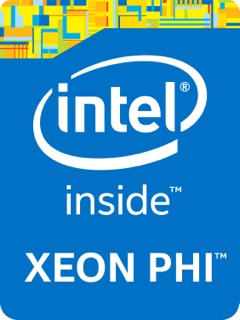Installation and Testing
Before attempting to build these versions you should have built and tested the serial
and parallel CPU versions of Amber (pmemd
and pmemd.MPI)
with the Intel compiler suite and Intel MPI. This will help to ensure that basic issues
relating to standard compilation on your hardware and operating system do not lead to confusion
with coprocessor related compilation and testing problems. You should also be familiar with Amber's compilation procedures.
The following section provides details on best options for compiling the latest AMBER 18 code with Intel and GNU compilers on
Intel hardware. It also provides details of how to compile AMBER 18 for the Intel Xeon Phi (Knight's Corner) co-processor as well
as it's upcoming replacement the Intel Xeon PhiTM (Knight's Landing) processor. You should only build executables for the hardware
you have available. There is no gain in using the KNC offload code on a KNL processor or the KNL compiled code on a regular Xeon
processor for example. In the case of the KNC co-processor it is recommended that you are familiar with building and running
simple code in native/offload mode on an Intel Xeon PhiTM KNC Coprocessor, which is described in the
MIC developer zone.
General Intel PMEMD Model
Building General Intel PMEMD Model
The standard PMEMD executables provide general Intel XeonTM
support that, as of update.3 to AMBER
16, offers improved performance on the
latest generation of Intel hardware. It
does this by introducing improved
vectorization but also addition of
OpenMP instructions. This changes
somewhat the method by which one runs
parallel PMEMD jobs to obtain maximum
performance and thus you are encouraged
to read both this section and the later
on running simulations on Intel CPUs
even if you are using standard Xeon
chips.
Assuming you have installed Intel Parallel Studio XE version 2013 or later, you can build
pmemd as follows:
cd $AMBERHOME
bashrc: export MKL_HOME=path-to-directory
[optional]
make clean
./configure intel
make install
Alternatively, GNU compilers can still be used:
cd $AMBERHOME
make clean
./configure gnu
make install
pmemd.MPI:
PMEMD parallel for Intel XeonTM can be built
with or without hybrid MPI/OpenMP
support. Building with just MPI is
effectively backwards compatible with
the way in which parallel jobs were run
in previous versions of AMBER. Remaining
with pure MPI is not expected to
negatively impact performance compared
with previous versions of AMBER and thus
is a reasonable choice when full
backwards compatibility with existing
run scripts etc is desired. Pure MPI
parallel support can be built using
Intel MPI (mpiicc/mpiifort)
from the Intel Parallel Studio XE
product, through the use of a new MPI flag (-intelmpi)
introduced with the release of AMBER 14.
You can build
pmemd.MPI
as follows:
cd $AMBERHOME
bashrc: export MKL_HOME=path-to-directory
[optional but recommended]
make clean
./configure -intelmpi intel
make install
Alternatively GNU compilers and your pick of MPI (openmpi, mpich, mvapich
etc) can be used:
cd $AMBERHOME
make clean
./configure -mpi gnu
make install
As of Amber16 PMEMD update.3, hybrid MPI/OpenMP
compilation is possible and can be built (only with Intel compilers) to take
advantage of OpenMP threading to
potentially increase performance. The
executable is named pmemd.MPI and
supports running both with and without
OpenMP threading depending on the
setting of the OMP_NUM_THREADS
environment variable although runs with
OMP_NUM_THREADS=1 might be marginally
impacted in performance over a
compilation without OpenMP support. (See
the running section below before running
with this executable):
cd $AMBERHOME
bashrc: export MKL_HOME=path-to-directory
make clean
./configure -openmp -intelmpi intel
make install
Intel® Xeon Phi™ Processor Family (Knights Landing -KNL) MIC2 PMEMD Model
Building KNL Xeon Phi PMEMD model
The Intel Xeon PhiTM support (added in update.3) adds a KNL optimized
pmemd.MPI
(that will run on regular Xeon but with
potential performance regressions).
pmemd.MPI:
PMEMD parallel for Intel Xeon PhiTM can be built using the MPI (mpiicc/mpiifort)
from the Intel Parallel Studio XE product
only. It is supported in Amber 18 through the use of a new
MIC2 flag (-mic2) that introduces Intel specific optimizations and optional (experimental) mixed
precision (-mic2_SPDP) support. Build
pmemd.MPI
as follows:
cd $AMBERHOME
bashrc: export MKL_HOME=path-to-directory
make clean
./configure -intelmpi -openmp -mic2 intel
or
./configure -intelmpi -openmp -mic2_SPDP intel [caution:
experimental at this time]
make install
Testing the KNL Xeon Phi PMEMD Model
You can run the test suite as
follows:
export DO_PARALLEL="mpirun -np 2"
export OMP_NUM_THREADS=2
make test.mic2
The majority of these tests should pass. Differences that occur on only a few lines and are
minor in nature can be safely ignored. Any large differences, or if you are unsure, should be posted to the
Amber mailing list for comment.
^
MIC Native PMEMD Model
Building the MIC Native PMEMD model
The MIC native version supporting the
first generation KNC Intel Xeon PhiTM co-processors is called
pmemd.mic_native (or
pmemd.mic_native.MPI
for running simulations in parallel on the coprocessor using MPI) and must be built
separately from the standard serial and parallel installations.
If you are not planning on running on a
KNC Intel Xeon PhiTM
co-processor you do not need to build
the native or the offload executables.
pmemd.mic_native
Assuming you have installed Intel Parallel Studio XE version 2013 or later, you can build
pmemd.mic_native as follows:
cd $AMBERHOME
make clean
./configure -mic_native intel
make install
pmemd.mic_native.MPI:
PMEMD parallel for KNC Intel Xeon PhiTM
(MIC) coprocessors can only be built using the MPI (mpiicc/mpiifort)
from the Intel Cluster Studio XE
product, which is supported from Amber 14
onwards through the use of a new MPI flag (-intelmpi). Build
pmemd.mic_native.MPI
as follows:
cd $AMBERHOME
make clean
./configure -mic_native -intelmpi intel
make install
It is possible to run across multiple Intel Xeon processors
and KNC Intel Xeon PhiTM coprocessors, even on a cluster, with this implementation.
However, it is a functional implementation and not performance optimized at this time.
Detailing how to run this way is beyond the scope of the current instructions;
however to see how to do this with MPI applications in general, see
Intel's web instructions.
At present it is not possible to run the
test suite in an automated fashion in
native mode.
MIC Offload PMEMD Model
Building the MIC Offload PMEMD Model
The KNC Intel Xeon PhiTM (MIC) offload version supporting
the first generation (KNC) of Intel Xeon PhiTM coprocessors is called
pmemd.mic_offload.MPI
and must be built separately from the standard parallel installation. MIC offload is not available in serial.
If you are not planning on running on a
first generation KNC Intel Xeon PhiTM
co-processor you do not need to build
the native or the offload executables.
pmemd.mic_offload.MPI
Assuming you have installed Intel Parallel Studio XE version 2013 or later, you can build
pmemd.mic_offload.MPI as follows:
cd $AMBERHOME
make clean
./configure -mic_offload intel
make install
There is no need to specify the -intelmpi flag as this is the default behavior of the configure script.
Testing the MIC Offload PMEMD Model
You can run the test suite using the MIC coprocessor with:
make test.mic_offload
The majority of these tests should pass. However, given the parallel
nature of the KNC MIC coprocessor, meaning the order of operation is not well defined, it is not
uncommon for there to be several 'possible FAILURES'. You should inspect the
.dif files created in the
$AMBERHOME/logs/test_amber_mic_offload/
directory to manually verify any 'possible FAILURES'. Differences that occur on only a few lines and are
minor in nature can be safely ignored. Any large differences, or if you are unsure, should be posted to the
Amber mailing list for comment.
^
Running
Simulations on Intel® CPU
These instructions are intended to
provide help with optimizing Intel XeonTM processor
performance.
For MPI-only PME, IPS or GB runs:
mpirun -np {mpi ranks} \
$AMBERHOME/bin/pmemd.MPI \
-O -i mdin -o mdout -p prmtop -c inpcrd
Set mpi ranks to number of processors being used for task.
Note it is advisable to test
performance as a function of MPI
Ranks since scaling is highly
system size, simulation option
and hardware dependent and using
more tasks does not always
provide greater performance once
the scaling limit has been
reached.
For MPI+OpenMP hybrid GB run:
export I_MPI_PIN_MODE=pm
export I_MPI_PIN_DOMAIN=auto
[these are important to ensure
OpenMP threads are properly
distributed between MPI tasks]
mpirun -np {sockets} -env OMP_NUM_THREADS={processors per socket} \
$AMBERHOME/bin/pmemd.MPI
-O -i mdin -o mdout -p prmtop -c inpcrd
It is advised to set sockets to number of physical chips being used, and OMP_NUM_THREADS to
the number of cores per chip.
For MPI+OpenMP hybrid PME or
IPS runs:
export KMP_BLOCKTIME=0
export KMP_STACKSIZE=200M
export I_MPI_PIN_DOMAIN=core
mpirun -np {mpi ranks} -env OMP_NUM_THREADS=2 \
$AMBERHOME/bin/pmemd.MPI \
-O -i mdin -o mdout -p prmtop -c inpcrd
It is advised to set 2 OMP Threads per mpi rank, and MPI ranks as "number of
real [non-hyperthreading] processor cores".
^
Running
Simulations on Intel® Xeon PhiTM Processors (KNL)
MIC2 PMEMD Model
In order to run a simulation on a
second generation (KNL) Intel Xeon PhiTM processor,
it is advised that you read the
Intel Xeon PhiTM Processor Developer's Quick Start Guide
[to be published shortly]
in addition to the instructions given
here. These instructions are created to provide guidance on maximizing the performance of the KNL system.
It should be noted that at this time the following is NOT
supported on KNL Xeon PhiTM processors: TI, EMIL,
Force Switch, IPS and Lennard Jones 12-6-4.
For GB workloads:
export I_MPI_PIN_MODE=pm
export I_MPI_PIN_DOMAIN=auto:compact
mpirun -np 4 -env OMP_NUM_THREADS={OMP Threads} -env KMP_AFFINITY="compact \
-env KMP_STACKSIZE=10M $AMBERHOME/bin/pmemd.MPI \
-O -i mdin -o mdout -p prmtop -c inpcrd
It is advised to set OMP Threads to number of physical cores on
the KNL chip. The number of MPI
tasks should always be left at
4.
For PME Workloads:
export KMP_STACKSIZE=200M
export KMP_BLOCKTIME=0
export I_MPI_PIN_DOMAIN=core
mpirun -np {MPI ranks} -env OMP_NUM_THREADS={OMP Threads} \
$AMBERHOME/bin/pmemd.MPI
-O -i mdin -o mdout -p prmtop -c inpcrd
It is advised to use "number of cores in the node" as MPI ranks, and 2 OMP Threads per mpi rank.
^
Running Simulations on Intel® KNC Xeon PhiTM Coprocessors
MIC Native PMEMD Model
In order to run a simulation on the
first generation KNC Intel Xeon PhiTM coprocessor,
it is advised that you read the
Intel Xeon PhiTM Coprocessor Developer's Quick Start Guide
in addition to the instructions given
here. This guide includes a description of the Intel Manycore
Platform Software Stack (Intel MPSS), which enables the wide range of usage models that
Intel Xeon PhiTM coprocessors support. Running a simulation on the coprocessor in native mode
requires that all files and binaries be visible to the coprocessor. Either mount your file system on the
coprocessor (requires root access) or explicitly transfer the binaries, libraries and input files to the
/tmp directory on the coprocessor.
Note: Mounting requires the Amber directory plus any additional libraries used in an Amber simulation
to be visible to the coprocessor.
Running Simulations with a Mounted Filesystem
- To mount a filesystem please follow the instructions available in the Intel MPSS readme file or follow this
this link.
- Mount your AMBERHOME directory, working directory, Intel compiler directory, Intel MPI_HOME directory
(for parallel run), and MKL_HOME directory (if MKL is used) on the coprocessor.
- Add the following environment variables to a file (source_knc.sh in this example),
which will be sourced on execution of
pmemd.mic_native:
export LD_LIBRARY_PATH=$LD_LIBRARY_PATH:$INTEL_COMPILER_HOME/lib/mic/
export LD_LIBRARY_PATH=$LD_LIBRARY_PATH:$MKL_HOME/lib/mic/
export LD_LIBRARY_PATH=$LD_LIBRARY_PATH:$MPI_HOME/mic/lib/
export PATH=$PATH:$MPI_HOME/mic/bin
- Run a simulation from your working directory on the host (CPU) with a mounted filesystem:
ssh mic0 "source source_knc.sh; \
$AMBERHOME/bin/pmemd.mic_native -O -i mdin -o mdout -p prmtop -c inpcrd"
Running Simulations without a Mounted Filesystem
- Upload the KNC Intel Xeon PhiTM coprocessor version of the Intel compiler library to the coprocessor:
scp -r $INTEL_COMPILER_HOME/lib/mic/* mic0:/tmp/
Similarly, upload the coprocessor versions of the MPI and MKL libraries:
scp -r $INTEL_MPI_HOME/mic/lib/* mic0:/tmp/
scp -r $INTEL_MPI_HOME/lib/mic/* mic0:/tmp/
Upload the coprocessor version of PMEMD (pmemd.mic_native/pmemd.mic_native.MPI
) and your working directory (containing the input files for simulation)
scp -r $AMBERHOME/bin/pmemd.mic_native mic0:/tmp/
scp -r working_directory/* mic0:/tmp/
Change the permissions of the libraries and binaries so that they are executable on the coprocessor:
chmod 777 -R /tmp/*
Finally run the simulation from the host:
ssh mic0 "export LD_LIBRARY_PATH=/tmp/; cd /tmp; \
./pmemd.mic_native -O -i mdin -o mdout -p prmtop -c inpcrd"
MIC Offload PMEMD Model
Unlike MIC native mode, once PMEMD has been configured with the -mic_offload flag and
compiled, no additional steps are required to run pmemd.mic_offload.MPI
. Work is automatically offloaded to the Intel
KNC MIC Architecture.
Execute the following command on the host to run a simulation in MIC offload mode:
mpirun -np 8 $AMBERHOME/bin/pmemd.mic_offload.MPI -O
Note: Choose the number of MPI processes to suit the specifications of the host CPU,
e.g. 8 MPI processes for an Intel Xeon E5-2680 8 core processor, in order to achieve optimum performance.
In the initial support for MIC offload in PMEMD, the amount of offloaded work to the coprocessor increases
and settles to a stable value after running multiple time steps governed by the Amber load balancer. Thus,
it is recommended that the simulation should run for at least 200 time steps to benefit from the coprocessor.
^
Considerations for Maximizing Intel® KNC Xeon PhiTM Performance using Offload Mode (recommended for advanced users, only)
The KNC MIC offload code uses OpenMP (OMP) threads to distribute the offloaded work across
the MIC coprocessor cores. The default number of OMP threads per offloading MPI process is set to 30; however,
this can be overridden by substituting the above execution command with the following advanced execution command
in this example runscript:
Run.mic_offload
#!/bin/bash
export MIC_ENV_PREFIX=PHI
export OMP_NUM_THREADS=1
mpirun -n 11 ./pmemd.mic_offload.MPI -O \
: -n 1 -env PHI_KMP_PLACE_THREADS 30c,4t,0O \
-env PHI_KMP_AFFINITY scatter \
-env PHI_OMP_NUM_THREADS 30 \
-env MIC_OMP_STACKSIZE 4M \
./pmemd.mic_offload.MPI -O \
: -n 1 -env PHI_KMP_PLACE_THREADS 30c,4t,30O \
-env PHI_KMP_AFFINITY scatter \
-env PHI_OMP_NUM_THREADS 30 \
-env MIC_OMP_STACKSIZE 4M \
./pmemd.mic_offload.MPI -O \
: -n 11 ./pmemd.mic_offload.MPI -O
"MIC_ENV_PREFIX=PHI" states that any environment variable prefixed with PHI will
be applicable to the KNC MIC coprocessor environment only (not the host processor environment).
"OMP_NUM_THREADS=1" states that the number of host OMP threads is 1.
In the MIC offload version of PMEMD only the middle two MPI processes are responsible for offloading work to
the MIC coprocessor, e.g. if 8 MPI processes are specified, threads 4 and 5 are responsible for offloading to the
MIC coprocessor. These two MPI processes simultaneously spawn OMP threads on the MIC coprocessor to execute the
offloaded chunks of work. By partitioning the execution command to reflect the decomposition strategy, the number of
OMP threads can be manually set. Partitioning of an MPI execution command is done via the use of ":" which is
demonstrated in the example runscript above.
In this example runscript for a 24 core Intel CPU augmented with a 61 core MIC coprocessor, 24 MPI processes are
requested on a single node. The first 11 MPI processes and the last 11 MPI processes execute on the host CPU cores.
The middle two MPIs (12 and 13) offload to a single MIC coprocessor and each spawn 30 OMP threads. The cores of the
MIC coprocessor are divided in two so that each MPI process is assigned half the cores of the MIC coprocessor. In
the above example, MPI process 12 spawns OMP threads on cores 1-30 whereas MPI process 13 spawns OMP threads on cores 31-60.
"-env PHI_KMP_PLACE_THREADS 30c,4t,0O" states that the MPI process will use 30 cores of the MIC coprocessor (30C),
may use as many as 4 threads per core (4T), and the first core that is being used has an offset of 0 (0O). Please consult
Intel's thread affinity documentation
for a more detailed explanation.
"-env PHI_KMP_AFFINITY scatter" states that the OpenMP threads will be mapped to the hardware threads in a scattered
fashion. Please consult Intel's compiler documentation for other options.
"-env PHI_OMP_NUM_THREADS 30" states that the MPI process uses 30 OpenMP threads.
It may be of benefit to performance to adjust the number of OMP threads to be spawned by each offloading MPI process
depending on the system being simulated, for example:
-env PHI_OMP_NUM_THREADS 60
For larger simulations (>200,000 atoms) more OMP threads, such as 2 threads per core (a maximum
of 4 threads per core is permitted on the MIC coprocessor), spawned on a MIC coprocessor provides better performance.
But for more OMP threads we need a larger stack size per thread and a larger total stack size on a MIC coprocessor.
The default stack size is 8 KB.
cd /vars/mpss/common
su
mkdir -p etc/security
Next create the file limits.conf (in /var/mpss/common/etc/security) containing the following line of text
(with tab separated values):
"* soft stack unlimited"
Create the file /var/mpss/common.filelist containing the following (with space separated values) lines:
dir /etc/security 755 0 0
file /etc/security/limits.conf etc/security/limits.conf 644 0 0
Finally, cycle the MPSS daemon to reboot the cards using:
service mpss restart
^
Recommended Hardware
In order to simplify the selection of hardware for AMBER
simulations on Xeon, KNC Xeon Phi and KNL Xeon Phi hardware we have teamed up
with Exxact Corporation to offer
preinstalled AMBER
Certified computing solutions this includes a
Xeon Phi Life Sciences Certified Solutions Program
developed jointly between Exxact, Intel and the lab or Prof.
Ross Walker. These systems can be ordered
with AMBER 16 preinstalled (AMBER license required)
and come with a full 3 year warranty. For details and to
customize systems please contact either Ross Walker (ross_at_rosswalker.co.uk)
or Mike Chen (mike@exxactcorp.com).
AMBER Certified
Entry-Level Workstation |
AMBER Certified
Mid-Level Workstation |
AMBER Certified
High-End Workstation |
 |
 |
 |
|
Ideal for Graduate Students |
Ideal for Researchers |
Maximum Performance |
|
1x Intel Core i7-4930K CPU
32 GB system memory
AMBER16 preinstalled and tested
CentOS 6 or 7
3 year warranty |
2x Intel Xeon E5-2620 v4 CPUs
1 Intel Xeon Phi 7120
64 GB system memory
AMBER16 preinstalled and tested
CentOS 6 or 7
3 year warranty |
2x Intel Xeon E5-2697 v4 CPUs
1 Intel Xeon Phi 7120
64 GB system memory
AMBER16 preinstalled and tested
CentOS 6 or 7
3 year warranty |
| ~$2500 |
~$4799 |
~$9999 |
Custom turnkey cluster solutions are also available.
Please email Ross Walker (ross at rosswalker.co.uk) or Mike
Chen (mike@exxactcorp.com)
for details.
^





